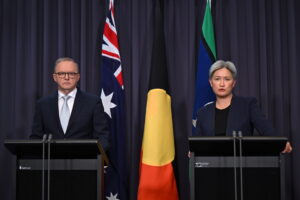Australians right across the country are calling out for cost-of-living relief, but the government doesn’t want to risk any measures that will increase inflation—keeping interest rates higher for longer, or worse, pushing them up even further.
When designing any cost-of-living measures, government’s aim to make sure they are targeted to those who need relief the most, those on low and middle incomes. But where is the middle income in Australia? It’s not where most people think it is.
Imagine if you put every working person in Australia in a line, with the lowest income earner working part time at one end, and Gerry Harvey and Gina Rinehart at the other end. The person right in the middle would be earning $67,000 a year, that is the median income. Half of workers earn less than $67,000 a year, half earn more.
If we only look at full time workers, the middle income was around $83,000 a year in 2024. For part time worker, more likely to women, the middle was closer to $40,000 a year. If you earn more than $180,000 a year, you earn more than 95 out of 100 workers in Australia, 95% of workers earn less than that.
Now, a sensible federal government would target its cost-of-living measures to give the bottom 95% of workers the most relief. But the Albanese government, is currently planning to implement the former Coalition government’s stage 3 income tax cuts package in full, beginning from 1 July this year – and unfortunately these tax cuts are primarily targeted at high-income earners.
The stage 3 tax cuts are the most expensive and most inequitable tax cuts in Australia’s history, costing an eye-watering $320 billion in their first ten years. Of that $320 billion, just under half will go to the top 10% of income earners.
While the Prime Minister is correct to say that everyone earning over $45,000 benefits from the stage 3 tax cuts, it’s pretty misleading. Bank CEOs, federal parliamentarians, and surgeons will get more than $9,000 a year from the Stage 3 tax cuts. While cooks, receptionists, hairdressers, and aged and disability carers will get nothing. A panel beater on the median income of $65,000 a year will receive around $500 a year.
Can you imagine if the Prime Minister and Treasurer announced the stage 3 tax cuts today? ‘Oh yes, we plan to give an extra $9000 a year to CEOs and politicians and just $460 a year to bus drivers’—in this economy? There’d be riots. We’d have a new Prime Minister by February.
But these tax cuts are deeply unfair in many other ways. Despite making up 12.7% of taxpayers, Gen Z (those under 25) will only receive 2.8% of the benefit in the first year of operation of the Stage 3 tax cuts. But women and those living in rural and regional areas will also largely miss out. Men will get two dollars for every dollar that women receive from the stage 3 tax cuts. Those living in wealthy inner-city electorates will get the most benefit; half of these electorates are in Sydney, and a quarter in Melbourne. Meanwhile, of the bottom 20 electorates which will receive the least benefit, 12 are rural seats.
While the federal government has argued it cannot afford to increase Jobseeker above the poverty line and are trying to rein in costs for the NDIS, Australia Institute research shows the stage 3 tax cuts will likely be responsible for up to 58% of the Budget deficit in 2024/25. If they were listed as expenditure, they would be the ninth most expensive program item in the budget.
The fact is the stage 3 tax cuts were a bad idea when they were first announced by Treasurer Scott Morrison and they are an even worse idea now. Economic circumstances have changed dramatically since then. Back then interest rates were low and so was inflation. Since then we’ve had a global pandemic, the war in Ukraine pushed energy prices up and inflation has become a global problem. In Australia, corporate profits were a large part of what was driving inflation. The Reserve Bank hit Australians with multiple interest rate rises in a row, and so the cost of mortgage repayments and the cost of rent have risen dramatically, alongside corporate profits. In fact, prices have gone up so much, including in supermarkets, there are at least two separate inquiries going at the moment. Introducing massive tax cuts during a period of high prices and high inflation makes little economic sense.
The Albanese government has done a good job so far of targeting measures to directly reduce prices where it can, reducing inflation. The measures to support bulk-billing, reduce the cost of prescription medicine and provide more rent assistance were all great measures.
The problem is the stage 3 tax cuts are by far and away the biggest cost-of-living measure the Albanese government will implement, dwarfing anything else it could possibly enact. They do not deliver enough to low and middle income earners, they hamper the government’s ability to enact other measures, plus they are inflationary.
The good news is, there are many ways the government could still redesign the tax cuts to make them fairer, better targeted and cheaper—and way less inflationary. The Australia Institute has modelled four alternatives, each of which would be between $70 billion and $130 billion cheaper over ten years, and which would deliver a bigger slice of the pie to 80% of taxpayers. It makes economic sense to redesign them and it certainly make much sense, ahead of an election year, to target the benefits of tax relief to the bulk of Australians, not the few.
If the government was designing a $320 billion tax cuts package today it would look nothing like Stage 3. They cost way too much and deliver far too little to those who need it. But there’s still time for Labor to avoid the worst of this costly electoral and economic mistake.
Between the Lines Newsletter
The biggest stories and the best analysis from the team at the Australia Institute, delivered to your inbox every fortnight.
You might also like
Middle, middle, middle class: Harris’ pitch to the heartland
Greg Jericho, Australia Institute Chief Economist, joins us to examine the Harris-Walz economic agenda.
As the US chooses destruction over diplomacy in Iran, Australia has to decide between principle and prostration
Australia, like Little Sir Echo, whimpers after the world’s premier bully bombs the ‘bully of the Middle East’.
The way we disagree
Press gallery veteran Paul Bongiorno joins us to discuss how conflict in the Middle East is reverberating through Australia and reconciliation one year after the Voice referendum.



